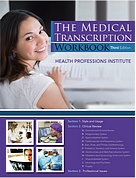Quiz - Week 31
Prefixes are used to express very large and very small numbers in many areas of medicine, including laboratory data, radiation therapy, and pharmacology. Can you match each prefix in column A to its meaning in column B? For an added challenge, show each term in its exponential form.
Prefix Matching:
Column A Column B
1. kilo- billion
2. micro- quintillion
3. femto- tenth
4. pico- thousand
5. deci- trillionth
6. exa- quintillionth
7. centi- thousandth
8. tera- quadrillionth
9. nano- million
10. mega- hundredth
11. giga- millionth
12. milli- trillion
13. atto- quadrillion
14. peta- billionth
Study Tip - Week 31
Using Print References
There are many reference books today for medical transcriptionists. Besides the Dorland's and Stedman's medical dictionaries (the only two we at HPI recommend) and glossaries like Vera Pyle's Current Medical Terminology and the Saunders Pharmaceutical Word Book, there are many word books (or spellers). Each of the major publishers puts out a comprehensive alphabetical speller (Dorland's and Stedman's again), but most word books are specialty word books devoted to a single specialty, such as cardiology or gastroenterology, or more often a group of related specialties. HPI has several such word books, which you can find on our website. Word books are basically just long spelling lists. They rarely, with the exception of Sloane's Medical Word Book, give you hints or clues about soundalikes and potential usage errors. This means that you must be very careful using word books. Inserting a correctly spelled but incorrectly used word into a report is an egregious error.
To find words in any print reference, it's important to know how that reference is organized. Always read ALL the front matter--the introduction, preface, how to use section, and if included, table of contents. Check for appendices and illustrations, tables, and other special features. Choose the correct reference for the task, a dictionary, glossary, or comprehensive speller if you are uncertain of the context or a specialty word book if you know the specialty, a pharmaceutical reference for drugs, etc.
Next, you need to know which letters or combinations of letters represent which sounds. While there are only 26 letters in the English alphabet, there are between 40 and 46 sounds or phonemes, depending on which authority you accept. One ESL website claims there are 52 sounds in English. For example, c, ck, ch, and k can all sound like k; f, ph, and gh can all sound like f. Vowels have long and short sounds and can also sound like each other. Marcy Diehl's Medical Transcription Techniques and Procedures contains a "Sound and Word Finder" table in its appendices, but you can find similar tables (without medical examples) by performing a Google search for "English phonemes" or "English Consonant and Vowel Sounds." When you cannot find a term the way you think it should be spelled, substitute another phoneme and try again.
When you do find a term that isn't spelled at all like you think it should be spelled, write that term, correctly spelled, in the margin on the page in the book where you initially thought it should be.
The Medical Transcription Workbook, 3rd edition
 The Medical Transcription Workbook is a best seller among medical transcription students and practitioners. The third edition has been thoroughly reformatted for the express purpose of helping both student and practitioner identify, learn, and assess their knowledge of medicine and professional issues. This edition includes the following:
The Medical Transcription Workbook is a best seller among medical transcription students and practitioners. The third edition has been thoroughly reformatted for the express purpose of helping both student and practitioner identify, learn, and assess their knowledge of medicine and professional issues. This edition includes the following:Style and Usage quick reference section, arranged alphabetically by topic, with hundreds of examples and exercise worksheets.
Clinical Medicine sections divided into major medical specialties or body systems. Previous sections in anatomy and physiology, medical terminology, pathophysiology, laboratory, and pharmacology are integrated within each medical specialty. Hundreds of worksheets with matching exercises, multiple choice, fill-in-the-blank, and true/false exercises are included in each section. Answers to the exercises are on a CD in the back of the book.
Professional Issues section with articles on the healthcare record, HIPAA and confidentiality, interpretation and editing of dictation, risk management, quality assurance, electronic resources, health in the workplace, and professionalism.
The readings and exercises also facilitate the preparation, taking, and passing of medical transcription employment and credentialing examinations. The new arrangement by medical specialty or body system is ideal for study groups and for supplementing textbooks in medical transcription education programs.
ISBN# 0-934385-99-8. Softcover, published in 2010. $40.
Answers to Quiz - Week 31
1. kilo- means tenth or 10 to the 1st power, as in kilometer
2. micro- means millionth or 10 to the 6th power, as in micrometer or micron
3. femto- means quadrillionth or 10 to the 15th power, as in femtometer or fermi
4. pico- means trillion or 10 to the 12th power
5. deci- means tenth or 10 to the 1st power, as in decimeter
6. exa- means quintillion or 10 to the 18th power, as in exameter
7. centi- means hundredth or 10 to the 2nd power, as in centimeter
8. tera- means trillion or 10 to the 12th power, as in terameter
9. nano- means billionth or 10 to the 9th power, as in nanometer (note that an angstrom is smaller at 10 to the tenth power)
10. mega- means million or 10 to the 6th power, as in megameter
11. giga- means billion or 10 to the 10th power, as in gigameter
12. milli- means thousandth or 10 to the 3rd power, as in millimeter
13. atto- means quintillionth or 10 to the 18th power, as in attometer
14. peta- means quadrillion or 10 to the 15th power, as in petameter
